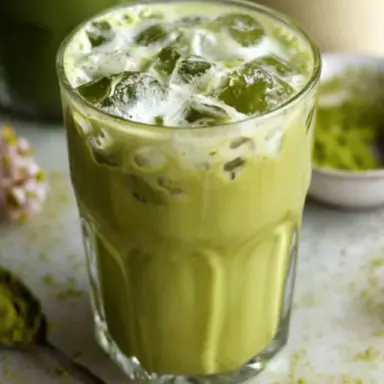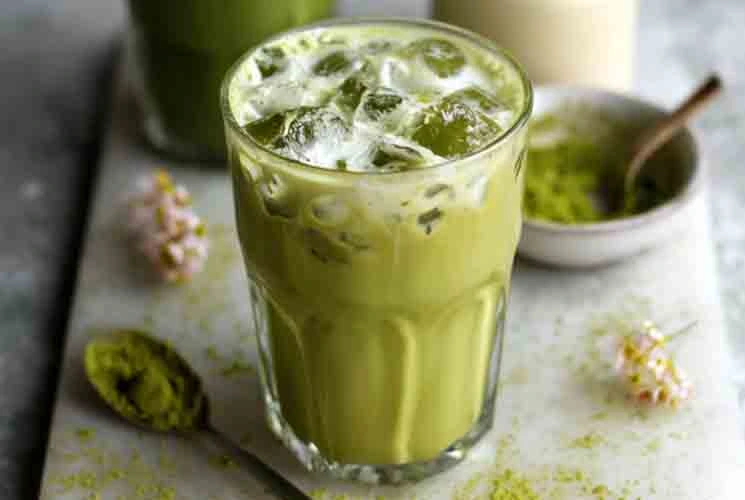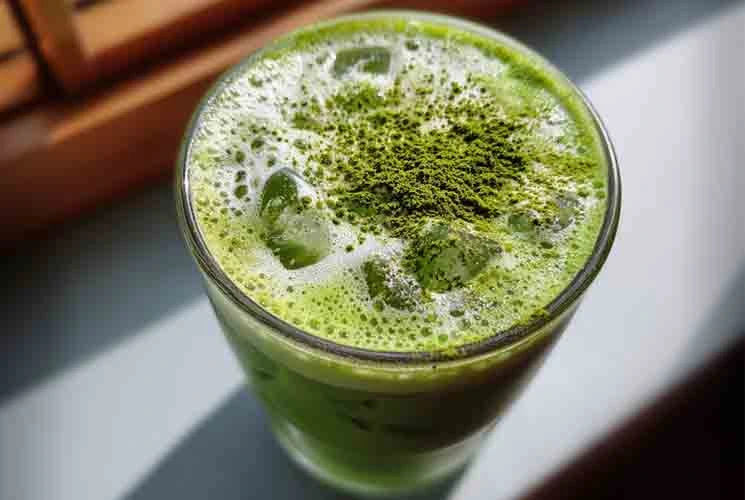Craving something cool, creamy, and energizing—but don’t want the sugar crash? The Low Calorie Iced Matcha Latte is the perfect solution. This vibrant green drink has taken over coffee shops and Pinterest boards alike, and for good reason. It blends the natural energy boost of matcha with the refreshing feel of an iced latte—without the extra calories.
Matcha lattes are silky smooth, slightly grassy, and delightfully satisfying. Best of all, you can customize them at home to keep things clean, low in sugar, and tailored to your dietary goals.
In this guide, you’ll discover everything you need to know: what matcha is, how it compares to green tea, the best ingredients to use, how to make your own iced version step-by-step, and helpful tips to avoid common mistakes. Whether you’re cutting calories, exploring new wellness drinks, or just curious about matcha, this guide will help you sip smarter.
What Is Matcha and Why It’s Perfect for Low Calorie Iced Matcha Lattes
Matcha is a finely ground powder made from specially grown green tea leaves. Unlike steeped green tea, where you toss the leaves after brewing, matcha lets you consume the entire leaf, which means more nutrients and antioxidants in every sip.
Originally from Japan, matcha has been used for centuries in tea ceremonies and meditation rituals. The leaves are shade-grown for weeks before harvest, which boosts chlorophyll and gives matcha its signature vibrant green hue and mild, umami-rich flavor.
But don’t confuse matcha with your everyday green tea bag. Matcha contains more caffeine and antioxidants, especially L-theanine, which promotes calm alertness. This makes it ideal for those looking for steady energy without the jitters of coffee.
Its earthy taste and powdered form make it incredibly versatile—perfect for hot lattes, smoothies, and of course, the ever-popular iced matcha latte that’s both satisfying and slimming.
Why Choose a Low Calorie Iced Matcha Latte?
Let’s face it—many café-style lattes are loaded with sugar and unwanted calories. That’s where the low calorie iced matcha latte comes in. You can enjoy this creamy green treat guilt-free, without sacrificing flavor or energy.
Unlike traditional coffee drinks filled with syrups and whole milk, this version is clean and customizable. It can contain as little as 30–50 calories, depending on your milk and sweetener choices.
Even better? Matcha delivers a unique blend of caffeine and L-theanine, giving you focused energy without the crash. It’s a great option for people on weight loss journeys, practicing intermittent fasting, or just looking for a better-for-you caffeine source.
And thanks to its high antioxidant content (especially EGCG), matcha may support fat metabolism and overall wellness. So not only does it taste amazing, but it works with your health goals instead of against them.
Ingredients for a Healthy Low Calorie Iced Matcha Latte
To make your own low calorie iced matcha latte at home, you’ll only need a few simple ingredients:
-
Matcha powder – go for high-quality ceremonial or culinary grade
-
Milk – use low calorie options like unsweetened almond milk, light oat milk, or skim milk
-
Sweetener – try stevia, monk fruit, or a touch of agave if needed (optional)
-
Filtered water – to help whisk the matcha
-
Ice – for that refreshing chill
You can also enhance your latte with optional add-ins like collagen powder or a drop of vanilla extract for a more indulgent flavor—without the guilt.
Best Matcha Powder for Iced Matcha Latte Recipes
Not all matcha is created equal. For iced lattes, you want matcha that blends smoothly and tastes clean—not bitter or dull.
You’ll often see two main grades:
-
Ceremonial grade: More vibrant, smooth, and delicate—ideal for drinking straight or in lattes
-
Culinary grade: Slightly stronger, perfect for mixing with milk or baking
For best results, choose an organic matcha from a trusted brand with no added sugars or fillers. Look for bright green powder, which indicates freshness and quality. Avoid anything yellowish or dull—that’s often a sign of poor storage or lower quality.
Pro Tip: Store matcha in an airtight container in the fridge for maximum freshness.
How to Make a Low Calorie Iced Matcha Latte (Step-by-Step)
Making a café-worthy iced matcha latte at home is easier than you think—and way more affordable. Here’s how to do it right:
Step 1: Sift Your Matcha
Use a small mesh strainer or fine sifter to remove clumps from 1 to 1.5 teaspoons of matcha powder. This ensures a smooth, lump-free drink.
Step 2: Whisk with Hot Water
Add 2 tablespoons of hot (not boiling) water—around 175°F or 80°C—to your matcha. Use a bamboo whisk (chasen) or a milk frother to whisk in a zig-zag motion until the matcha is fully dissolved and slightly frothy.
Alternative: If you don’t have a whisk, shake the matcha and water together in a sealed jar.
Step 3: Add Cold Milk & Sweetener
In a tall glass, add ice cubes and pour in 1 cup of cold low-calorie milk (like unsweetened almond or light oat milk).
Then, stir in your sweetener of choice: stevia, monk fruit, or sugar-free vanilla syrup work great.
Step 4: Combine & Serve
Pour your whisked matcha over the milk and ice. Give it a gentle stir and enjoy!
Optional Add-ins:
-
1 scoop collagen peptides for skin & joint benefits
-
1/2 tsp vanilla extract for a café-style flavor
Troubleshooting Tips:
-
Clumps? Make sure you sift and whisk well
-
Bitter taste? Use less matcha or opt for a higher grade
-
Too weak? Try adding a touch more matcha or less milk for a stronger flavor
Now you’re ready to enjoy a creamy, chilled, energizing drink—all with low calories and high satisfaction.
Health Benefits of Low Calorie Iced Matcha Latte
Matcha isn’t just trendy—it’s legitimately good for you. When made low calorie, an iced matcha latte becomes a functional drink that goes beyond hydration or caffeine kicks.
First, matcha is rich in EGCG (epigallocatechin gallate), a potent antioxidant linked to supporting fat oxidation, reducing inflammation, and protecting your cells from damage. It’s one of the most concentrated sources of antioxidants you can sip.
Then there’s L-theanine, a naturally occurring amino acid in matcha that promotes calm alertness. Unlike coffee, which can cause jitters and a hard crash, matcha gives you sustained, focused energy. L-theanine also supports mood and cognitive function—perfect for a mid-day mental boost.
Plus, matcha may support metabolism and assist with fat burning, especially when consumed consistently as part of a balanced diet. Studies suggest it can gently increase calorie expenditure during rest or exercise.
And since you’re skipping the sugar and using a light milk base, this drink becomes a low calorie way to get antioxidants, hydration, and clean energy all in one glass. It’s no wonder so many people make it part of their daily wellness ritual.
Best Sweeteners to Keep It Low Calorie
Keeping your matcha latte low calorie means avoiding added sugar—but that doesn’t mean it has to taste bland.
Some great natural options include:
-
Stevia (zero-calorie, plant-based)
-
Erythritol (sugar alcohol with minimal impact on blood sugar)
-
Monk fruit (a clean, keto-friendly choice)
-
Sugar-free syrups (just check for artificial additives)
To avoid a chemical aftertaste, start small and taste as you go. A little goes a long way—especially with stevia or monk fruit. You can also combine sweeteners (like a dash of monk fruit with a drop of vanilla) for smoother flavor. Personalize to your palate!
Best Milk Options for Low Calorie Matcha Latte
Choosing the right milk can make or break the flavor and calorie count of your iced matcha latte. Here’s how top options compare:
-
Unsweetened Almond Milk: Around 30–40 calories per cup, mild flavor, thin texture. Great base for matcha and very low carb.
-
Low-Sugar Oat Milk: Typically 45–70 calories per cup, naturally sweet, creamy mouthfeel. Just check for added sugar in some brands.
-
Skim Milk: About 80–90 calories per cup, more protein and calcium, but higher carb. Still a good option if you’re okay with dairy.
-
Coconut Milk (carton, not canned): Around 45 calories per cup, adds a tropical note, but be mindful of added sweeteners.
For the creamiest result with the lowest calories, unsweetened almond or oat milk are usually the top picks. Always check labels for “unsweetened” or “no added sugar” to stay in that low-calorie lane.
Make-Ahead and Storage Tips
Yes, you can batch your iced matcha lattes—but with a few caveats.
Make the matcha concentrate (powder + water) ahead and store it in the fridge for up to 3 days in a sealed jar. This way, you can mix with fresh milk and ice whenever you need a boost.
Avoid prepping the full latte with milk and ice in advance—it tends to separate and lose freshness. If separation happens, just shake it well or blend for 10 seconds to revive the texture.
For busy mornings, pre-mix your ingredients in a shaker bottle and stash it in the fridge overnight!
Low Calorie Iced Matcha Latte Variations You’ll Love
Once you master the classic iced version, there are so many fun, flavorful ways to personalize your low calorie matcha latte:
Iced Vanilla Matcha Latte
Add 1/2 tsp sugar-free vanilla extract or a splash of vanilla-flavored unsweetened almond milk. It gives your drink a cozy, creamy twist—like dessert in a glass.
Iced Matcha with Protein
Blend in 1 scoop of vanilla or unflavored protein powder (choose a clean, low-sugar option). This turns your drink into a post-workout energy bomb.
Mint Matcha Latte
Steep a few fresh mint leaves in your hot matcha water, then chill. The mint cools things down naturally and pairs beautifully with matcha’s earthiness.
Frozen Matcha Smoothie
For a thicker, slushie-like treat, blend matcha with ice, almond milk, and half a frozen banana alternative (like zucchini or avocado for low-carb). Creamy, frosty, and totally refreshing.
Each version keeps things light while adding a new twist of flavor, texture, or purpose. Just remember to keep sweeteners and milk light to stay in the “low calorie” zone!
Common Mistakes to Avoid
Even a simple drink like iced matcha can go sideways if you’re not careful. Watch out for these common missteps:
-
Using boiling water – It burns the matcha and makes it bitter. Stick to ~175°F (not boiling).
-
Skipping the whisk or sift – You’ll end up with chalky clumps. Always sift your powder and whisk well.
-
Unknowingly using sweetened milk – Many non-dairy milks sneak in sugar. Always check for “unsweetened” on the label.
-
Buying low-grade matcha – Dull, yellowish powder means poor quality and a bad taste. Go for bright green, clean-label matcha.
A few tweaks make a huge difference in flavor and texture.
Final Thoughts & Sip-Worthy Wrap-Up
A low calorie iced matcha latte is more than just a pretty drink—it’s a refreshing, energizing, and wellness-forward habit. It’s easy to make, endlessly customizable, and packed with benefits. Whether you’re starting your day or cooling off post-workout, this green drink might just become your new favorite ritual.
FAQs
Is iced matcha good for weight loss?
Yes! Thanks to its metabolism-boosting compound EGCG and its natural caffeine + L-theanine combo, matcha may help support fat burning while keeping energy stable—making it ideal for weight management.
How many calories are in an iced matcha latte with almond milk?
When made with unsweetened almond milk and no added sugar, a typical iced matcha latte contains 30–50 calories, depending on your milk volume and sweetener choice.
What is the healthiest way to sweeten an iced matcha latte?
Natural, zero-calorie sweeteners like stevia or monk fruit are best. You can also use a splash of sugar-free vanilla extract to enhance flavor without sugar.
Can I drink a low calorie matcha latte daily?
Absolutely. Drinking a matcha latte daily is fine for most people and provides steady energy, antioxidants, and hydration. Just keep caffeine in mind—especially if you’re sensitive.

Low Calorie Iced Matcha Latte
Equipment
- Small sifter or mesh strainer
- Matcha whisk (chasen) or milk frother
- Glass or shaker jar
- Spoon or stirrer
- Measuring spoons
Ingredients
- 1 to 1½ tsp matcha powder ceremonial or culinary grade
- 2 tbsp hot water about 175°F / 80°C
- 1 cup unsweetened almond milk or low-calorie milk of choice
- Ice cubes enough to fill glass
- ½ –1 tsp stevia monk fruit, or sugar-free sweetener (optional)
- Optional: ½ tsp vanilla extract 1 scoop collagen peptides
Instructions
- Sift the matcha into a bowl or jar to remove clumps.
- Add hot water and whisk vigorously (in a zigzag motion) until smooth and slightly frothy.
- Alternative: shake matcha and water together in a jar.
- Fill a glass with ice and pour in your cold low-calorie milk.
- Add sweetener and optional flavorings, then pour in the whisked matcha.
- Stir gently, sip, and enjoy your refreshing low calorie iced matcha latte!
Notes
- Matcha Tip: Always use hot, not boiling water to avoid bitterness.
- Milk Swap: Use unsweetened oat, skim, or coconut milk as alternatives.
- Make-Ahead: Mix matcha + water concentrate in advance and store in fridge for up to 3 days.
- Flavor Tip: Add mint, vanilla, or sugar-free syrups for fun variations.
Nutrition
Conclusion: A Sip-Worthy Ritual You’ll Love
Whether you’re chasing a cool caffeine boost, cutting back on sugary drinks, or just want a daily ritual that feels indulgent but fuels your body, the Low Calorie Iced Matcha Latte checks every box.
It’s easy to make, endlessly customizable, and packed with benefits—from focused energy to antioxidants that support your overall wellness. And the best part? You don’t have to sacrifice flavor or fun to stay on track with your health goals.
So go ahead—whisk, pour, and sip your way to better energy and feel-good hydration. Once you make it at home, you’ll never look at the coffee shop version the same way again.
Pro tip: Keep experimenting with different milks, sweeteners, or flavor twists to find your perfect blend. Your taste buds (and your body) will thank you!


